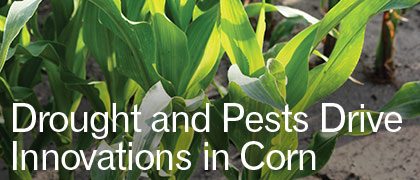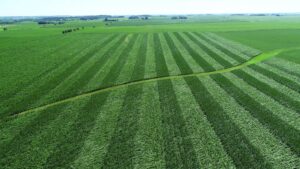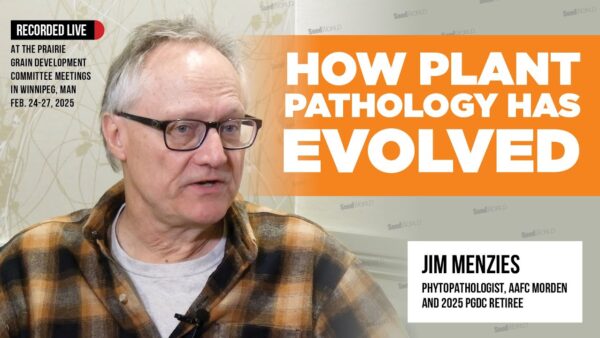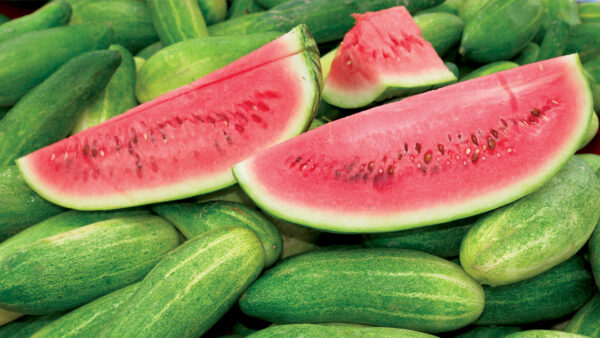Resistant pests and better water use efficiency are high priorities for corn growers and for seed companies developing new corn varieties and hybrids.
The growing trend towards corn on corn has increased insect pressure and elevated the risk of resistance to existing technologies in pests such as corn rootworm. Monsanto has already committed $6 million to the Corn Rootworm Knowledge Program, which supports research in the areas of CRW management and control. At the same time, more and more farmers recognize the importance of stewardship in keeping existing crop protection traits strong, and most want refuge-in-a-bag solutions to make the process easier.
“Customers want simplicity,” says Reed Mayberry, senior corn marketing manager for DuPont Pioneer, which will be offering more of its products as a single-bag refuge option in 2014. “Over two-thirds of our supply for 2014 will be integrated solutions for customers to truly make it easy for them.”
Syngenta will offer the first new trait for CRW in five years with its Agrisure Duracade product. “It’s a hybrid of two different Bt proteins, and it’s the world’s first Bt hybrid protein, eCry3.1A, that has activity on CRW,” says Jill Wheeler, product lead, commercial traits for Syngenta.
Many breeding pipelines include corn hybrids that will offer better resistance to diseases such as Goss’s wilt, gray leaf spot and stalk rot diseases such as fusarium, anthracnose, Gibberella and Diplodia. “Goss’s wilt has spread further north and west in the last couple of years, so we will continue to offer products that have natural Goss’s wilt resistance,” says Mayberry.
Yield data has shown that the 2012 U.S. drought didn’t have nearly the impact some feared—a credit to improved genetics and traits available in corn.
Drought Stress
Water scarcity is an ongoing issue for many U.S. corn growers, and many seed companies are working on improved drought tolerance in future lines. Syngenta is working on the next generation of its Agrisure Artesian products, which currently incorporate a native trait and multiple genes that help plants use water more efficiently. “We have genetically modified traits also in our pipeline, so there is certainly the possibility over the next several years for a combination of GM and native traits to help growers produce more with water scarcity,” says Pat Steiner, head of the corn portfolio for Syngenta.
Erratic weather patterns are pushing the development of hybrids that can perform both under drought stress conditions, but also when conditions are good. DuPont Pioneer has tested its Optimum AQUAmax family of corn hybrids against other corn hybrids in 200+ on-farm studies under both water-limited and favorable conditions. “AQUAmax is delivering yield stability in a low-end yield situation and high-end yield potential in more favorable moisture conditions,” says Mayberry.
Farmers on the western Great Plains also had the chance to try out a new drought-tolerant corn hybrid jointly developed by Monsanto and Bayer CropScience, and Monsanto’s second-generation drought-tolerant trait for the central Corn Belt is in the works.
Stacks and Pyramids
Stacked products, combining multiple modes of action, are constantly evolving to offer new options for farmers struggling with pest, weed and disease resistance issues.
Monsanto’s next generation herbicide-tolerant corn will offer three herbicide tolerances to glyphosate, dicamba and glufosinate. Meanwhile Dow AgroSciences’ new Enlist corn will give tolerance to both glyphosate and Dow’s new 2,4-D formulation. The timing for launch of both these products is dependent upon regulatory approvals.
Dow and Monsanto have also signed cross-licensing agreements that will combine Monsanto’s third-generation CRW technology and Dow’s next-generation SmartStax products to provide multiple insect-resistant and herbicide-tolerant traits in one product.
Pyramids are the next evolution in combined traits. “A stack is two different traits targeting two different pests, for example a corn borer trait and a corn rootworm trait,” says Mayberry. “A pyramid is two traits targeting one pest. For example, Optimum AcreMax XTreme [has] two modes of action for above ground insect control and two modes of action for below ground insect control. Two traits targeting the same pest is a much better approach to extending the durability of insect traits in our industry.”
Genetics
Genetics will be key in providing the yields that farmers are looking for over next few years, says Tim Welbanks, lead agronomist with Maizex Seeds Inc. “Breeding companies are going to be using things like molecular markers and seed chipping to offer high-yielding genetics,” he says. “Those companies are going to keep the corn yield curve going up.”
All seed companies continue to access improved germplasm from global sources. Syngenta gained access to six different sets of germplasm several years ago, which has allowed the company’s breeders to bring a step change in product performance, says Steiner. Syngenta’s Agrisure technology has improved both yields and quality, says Wheeler. “I think grain quality is a thing you will be hearing more about as we move forward,” she adds.
It’s not just traits and chemistries that are being stacked in new corn hybrids to provide multiple benefits to growers. Monsanto will be the first company to bring RNA interference technology to the marketplace for control of insects in corn and soybeans. “The final product will have three modes of action targeting corn rootworms,” says Ron Flannagan, corn insect traits platform lead at Monsanto. “Two of the modes of action will be existing Bt traits from our lineup and we will add the RNAi technology, which uses a naturally-occurring system within the insect to cause toxicity.”
A non-biotech approach to pest management still in its early stages is the use of biological controls, says John Chambers, corn technology lead at Monsanto. “We’re looking at using naturally-occurring products for many things, such as weed control, insect control, disease, even virus control,” he says. “We have a nematicide product in the near term that will be added to our Acceleron corn seed treatment system.”
There are many factors that can rob a farmer of yield, so it’s vital to have the right products on every acre, and with all the options available in corn, growers need help to make sure they can protect and improve their yields, says Welbanks, who routinely conducts three years of testing before offering new products to his customers. “Stable yield is huge right now, so growers are not only looking at traits, but it has to be in good genetics,” he says. “We’ve got the opportunity to go with almost any trait out there, but there are some trait offerings that you can’t get in the top genetics, so it might protect his crop from some kind of insect pressure, but if it’s 15 or 20 bushels behind something else, then he’s likely to say no. He’s got to have the combination of genetics with the right traits.”
Angela Lovell












